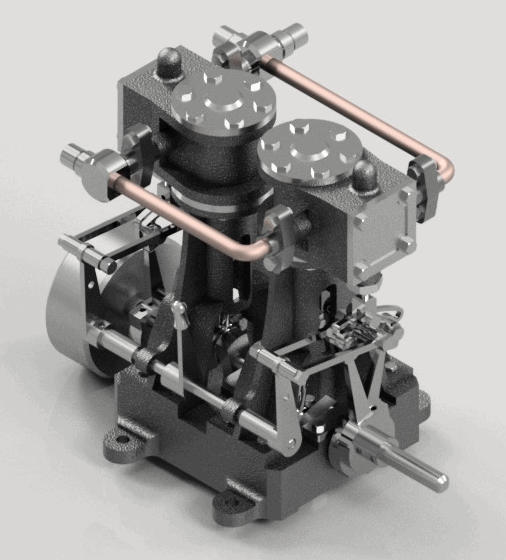& Construction

Integrated BIM tools, including Revit, AutoCAD, and Civil 3D
& Manufacturing

Professional CAD/CAM tools built on Inventor and AutoCAD
4 min read
I always love to hear how someone gets introduced to CAD, and better than that, how they adapt and grow as their needs change and new tools become available. Below, Ryan Cazin explains just that, going from Inventor and SolidWorks to Fusion for his horizontal twin cylinder engine design. If you’ve ever changed CAD packages, or are currently looking into Fusion 360 as your next design tool read on to see how easily the transition was for Ryan, even with something as complex as engine design.
A little about myself:
My name is Ryan Cazin and I am originally from Burlington, Iowa. I am currently attending Iowa State University in pursuit of a degree in Aerospace Engineering with a minor in Nondestructive Evaluation. At ISU, I am a member of the marching and pep bands as well as helping to conduct research on campus with nanoenergetic particles and green, high performance rocket propellants.
Where did I begin with CAD and how I learned:
I started working with CAD my freshman year of high school in the Intro to Engineering class of the Project Lead the Way (PLTW) initiative to increase interest in STEM fields. We made simple objects and assemblies such as a puzzle cube and a small toy train within Autodesk Inventor. From that point on, I found myself consistently finding a new project, finding something else to make, and really just finding something else to learn and hone my growing knowledge.

Sophomore year of high school I began constructing an enthusiast scale train of a Shay locomotive designed by Kozo Hiraoka. Initially, I wasn’t as involved with the project, as I would only make a few parts here and there and it never really made a dent in the project. After a year had passed, I entered into the 3D CAD Engineering competition. The competition consisted of modeling a particular assembly given at the beginning of the competition within a four hour time period to make all parts, assemblies, and to recreate the blueprints. To my surprise, I won the state competition and was invited to compete at nationals in Nashville, Tennessee.. At this competition, I ended up placing 14th in the nation. After being unhappy with the result, I decided to model much more and try again my senior year. Continuing much more diligently with the Shay locomotive, I was learning to become faster and more efficient with my work and finished the 1,000+ part assembly before the state competition. With this practice, I was able to win the state TSA competition once more and was invited to compete at nationals in Orlando, Florida.. I was able to place first at the national competition in 3D CAD Engineering due to my work in teaching myself how to model efficiently and quickly.
What I do currently and where I want to be:
My current work is a mix between personal projects and designing various components for the research lab I work in. My designs to this point have really been driven by personal interest and wanting to build up a portfolio of different types of models. I have worked from designing model train cars to be 3D printed for a model layout, to making steam engines (including the horizontal twin this month), to now constructing a jet turbine and learning modeling within the aerospace field. My work in my research lab consists of designing pressure vessels for nanoscale reactive materials as well as new rocket propellants, working in Inventor as well as Solidworks. My future goals are to become a researcher or design engineer within the aerospace industry in either aircraft flight or space applications.


The project and Fusion 360 experience:
I was contacted by Chris Hall of Autodesk for the Holiday Student Modeling Project which is how I was introduced to Fusion 360. I was very interested in a platform that allowed multiple users to work in conjunction. With it, I designed the vertical French twin cylinder steam engine. This project was met with some difficulty as performance of the program suffered under mechanical assemblies in some regards. After this, I was contacted again for a follow up project which is where I designed the horizontal twin cylinder engine. In using Fusion 360 this time around, the functionality was much better in my opinion and I became aware of how to counter the problems I faced in the first model. Problems such as slow assembly motion and crashing were no longer experienced. In the horizontal twin, design was much more fluid and the model operated much better. Although I still work in Inventor and SolidWorks primarily, I find that the ease of modeling within Fusion 360 for smaller assemblies is unmatched. In addition to this, the rendering capabilities of Fusion 360 are incredible to be able to use directly through the program.
Congratulations to Ryan for his awesome engine design(s)! It’s great to see Fusion 360 becoming so prevalent in education as well as industry. If you’ve gone from Inventor, SolidWorks or another CAD package to Fusion 360, I’d love to hear your story as well. Feel free to reach out to me at james.herzing@autodesk.com and let me know. Maybe you could be selected for the Model of the Month next!
By clicking subscribe, I agree to receive the Fusion newsletter and acknowledge the Autodesk Privacy Statement.
Success!
May we collect and use your data?
Learn more about the Third Party Services we use and our Privacy Statement.May we collect and use your data to tailor your experience?
Explore the benefits of a customized experience by managing your privacy settings for this site or visit our Privacy Statement to learn more about your options.